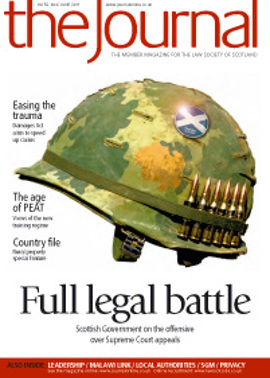One for the accused to prove

Diminished responsibility and the burden of proof
Although it is clear that there is an onus on an accused who contends that his responsibility for the charge he faces is diminished, it seems never to have been authoritatively decided whether that onus is legal or merely evidential. This was the main issue before a bench of five judges in the murder case of Lilburn v HM Advocate [2011] HCJAC 41 (26 April 2011), where the argument for the appellant proceeded largely by analogy with the position in relation to provocation.
In the latter case, there is no legal burden on the accused: Drury v HM Advocate 2001 SCCR 583, and it was said that the public policy considerations in respect of both provocation and diminished responsibility were the same. Indeed, the similar nature of the concepts in each had recently been examined in HM Advocate v Kerr 2011 SCCR 192; in any event to impose a legal burden on an accused to establish diminished responsibility was inconsistent with the presumption of innocence. It was submitted that the burden was evidential only; if the accused satisfied that burden it would be for the Crown to prove beyond reasonable doubt and by corroborated evidence that the accused was fully responsible for his actions.
These arguments were roundly rejected in a unanimous opinion of the appeal court, which confirmed what had been regarded as settled practice: an accused required to prove on balance of probability that his responsibility was diminished. Nothing had been said in the leading case of Galbraith v HM Advocate 2001 SCCR 551 to suggest that this settled practice was wrong; and it would have statutory effect when s 168 of the Criminal Justice and Licensing (Scotland) Act 2010, which followed a recommendation by the Scottish Law Commission, was brought into force. In particular, there were important differences between provocation and diminished responsibility: the former was primarily concerned with an accused’s immediate reaction to external circumstances, while the latter was primarily concerned with the internal state of the accused’s mind. The appeal against conviction was refused.
Apparent bias?
In considering the question of declinature of jurisdiction on the basis of apparent (as opposed to actual) bias, the test is well established. It was articulated in Bradford v McLeod 1985 SCCR 379 and put succinctly in Porter v Magill [2002] 2 AC 357, where at para 103 Lord Hope put the matter thus: “The question is whether the fair-minded and informed observer, having considered the facts, would conclude that there was a real possibility that the tribunal was biased”. So what should happen when a JP is a witness to an incident of careless driving and the driver later appears for trial in Aberdeen JP court where that JP regularly presides, although the case calls for trial before another JP from another part of the sheriffdom?
This was the situation in PF Aberdeen v Pirie [2011] HCJAC 43 (28 April 2011), where before the trial started a devolution minute was lodged claiming that the Crown, in attempting to prosecute the case in that JP court, infringed the right of the accused to a fair trial. The presiding JP granted the minute, taking the view that since both he and the witness were JPs serving in the same sheriffdom (albeit in different courts) and attending the same training courses with a concomitant degree of possible social contact, an independent third party might reasonably doubt that he would be able to treat the evidence of his judicial colleague with complete impartiality, even although he did not know him personally.
This decision was reversed on appeal to the High Court, which rejected an argument that because of the common judicial bonds between justices serving in a small court there was a potential for unconscious bias; it was a matter of impression. The appeal court proceeded on the basis that an informed observer would adopt a balanced approach, and concluded that it could not be taken that the presiding justice would be inclined to accept the word of the JP witness as against the word of any other witness. There was nothing in the nature of a conflict of interest; the presiding justice was bound by his judicial oath or affirmation and had with him on the bench a qualified legal adviser. The case was remitted for trial, the court commenting that it “might be thought appropriate” for it to be presided over by a different justice and legal adviser from another part of the sheriffdom.
Salduz, Cadder, s 118 and waiver
Further twists in the post-Salduz/Cadder tale continue to be litigated. In Jude v HM Advocate [2011] HCJAC 46 (11 May 2011) three separate appeals were conjoined. In each case the defence had failed to object to evidence led as to the contents of a police interview conducted with the accused while detained as a suspect and in the absence of legal advice; further, each accused had apparently waived his right to legal advice. The Court decided to deal with Crown arguments on these matters as a preliminary to a consideration of various other grounds of appeal which raised article 6 points.
Section 118(8) of the 1995 Act provides broadly that if it is to be suggested on appeal that inadmissible evidence has been led at a jury trial at which the accused was legally represented, a conviction cannot be set aside unless timeous objection was made to that evidence. This section led the Crown to argue before the appeal court that since no timeous objections based on the Salduz principle had been made in any of the cases, the appeals could not succeed. This was rejected on the straightforward ground that at the time the respective trials took place, Cadder had not yet been decided by the Supreme Court, even though the line of authority starting with Salduz had started to develop and had reached various stages by the time of each trial. Salduz objections to the evidence would therefore have been bound to fail.
On the question of waiver, the Crown argued, first, that at the time of his interview each appellant had waived his right of access to a lawyer; and secondly, that by his failure to object at the trial, each appellant had waived his right to take the point as a ground of appeal. The court accepted that the rights of a detainee or an accused under article 6 could be waived, but rejected the first Crown argument because the law at the time did not allow the accused to have access to a lawyer at that stage of pre-trial procedure, and because the appellant’s consent to be interviewed in each case was not informed by legal advice. If the appellant, in fact, answered questions he could not be held to have waived his right to legal advice when such a right was not recognised by the Scottish courts and was excluded by s 14 of the 1995 Act. The argument based on failure to object at trial was also rejected, because of the court’s decision on the s 118 argument.
In the appeal by Raymond Jude one other point arose. This related to a Crown argument on s 100(3B) of the Scotland Act 1998, which provides for a time bar on proceedings brought after 2 November 2009 based on the alleged incompatibility with Convention rights of an act by the Scottish Ministers or a member of the Scottish Executive. Contrary to the view of Lord Rodger in Cadder, the court held that s 100 had no application, since the appeal was brought under the 1995 Act rather than under the Scotland Act and not by means of civil proceedings. All the appeals were continued for further hearings.
Punishment parts: continued
As noted in my last column, the sentence appeal in Petch v HM Advocate 2011 SCCR 190 was remitted to a court of three judges by the bench of seven before whom the appeal had been heard in the latter part of 2010. The issue was of course the proper approach to the computation of the punishment part of a discretionary life sentence, something on which the seven judges had expressed differing opinions. However, the majority view was that the exercise had to be conducted in three stages, involving first the selection of the notional determinate sentence which might have been selected if a life sentence had not been; then stripping out therefrom the whole of any element for public protection; and lastly, selecting half (or perhaps up to two thirds) of the resulting period in order to come to the final conclusion.
The appeal has now been finally determined: Petch v HM Advocate [2011] HCJAC 50 (18 May 2011). The appellant had been convicted of appalling and depraved rapes of children; he had a previous conviction for assault with intent to ravish; and background reports referred to his deviant sexual interest in violent and coercive behaviour with young and pre-pubertal females.
These factors alone were sufficient for the court to reject the argument that discretionary life should not have been imposed, but the court reduced the punishment part selected by the sentencing judge from 12 to eight years. He appeared to have doubted the practicability of the particular statutory provisions which had to be applied and had wrongly interpreted them, particularly at the second and third stages.
In this issue
- Breaking new ground
- A&A accounts and abatements
- What price privacy?
- Power struggle
- Rural peace?
- Damages for our times
- Grief revalued
- Up to speed?
- Into Africa
- Expenses review opens with invitation on issues
- Law reform update
- From the Brussels office
- Dundee students join advice network
- The learning curve
- Ask Ash
- Guiding hands
- Marriage made in heaven?
- Email on the spot
- One for the accused to prove
- Going for growth
- A brake on termination?
- The colour yellow
- All change on the croft
- Natural justice in play
- Website review
- Book reviews
- A time of opportunity
- Rural property - Who wants to be a green wellie conveyancer?
- Rural property - Buying and selling: pitfalls and problems
- Rural property - In the taxman's sights
- Rural property - Farm tenancies: more changes imminent
- Now we are 10






